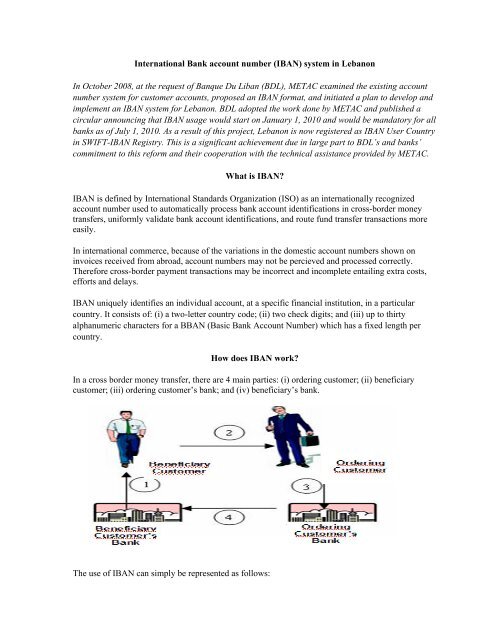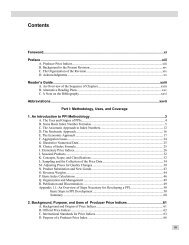International Bank account number (IBAN) system in ... - METAC
International Bank account number (IBAN) system in ... - METAC
International Bank account number (IBAN) system in ... - METAC
Create successful ePaper yourself
Turn your PDF publications into a flip-book with our unique Google optimized e-Paper software.
<strong>International</strong> <strong>Bank</strong> <strong>account</strong> <strong>number</strong> (<strong>IBAN</strong>) <strong>system</strong> <strong>in</strong> Lebanon<br />
In October 2008, at the request of Banque Du Liban (BDL), <strong>METAC</strong> exam<strong>in</strong>ed the exist<strong>in</strong>g <strong>account</strong><br />
<strong>number</strong> <strong>system</strong> for customer <strong>account</strong>s, proposed an <strong>IBAN</strong> format, and <strong>in</strong>itiated a plan to develop and<br />
implement an <strong>IBAN</strong> <strong>system</strong> for Lebanon. BDL adopted the work done by <strong>METAC</strong> and published a<br />
circular announc<strong>in</strong>g that <strong>IBAN</strong> usage would start on January 1, 2010 and would be mandatory for all<br />
banks as of July 1, 2010. As a result of this project, Lebanon is now registered as <strong>IBAN</strong> User Country<br />
<strong>in</strong> SWIFT-<strong>IBAN</strong> Registry. This is a significant achievement due <strong>in</strong> large part to BDL’s and banks’<br />
commitment to this reform and their cooperation with the technical assistance provided by <strong>METAC</strong>.<br />
What is <strong>IBAN</strong><br />
<strong>IBAN</strong> is def<strong>in</strong>ed by <strong>International</strong> Standards Organization (ISO) as an <strong>in</strong>ternationally recognized<br />
<strong>account</strong> <strong>number</strong> used to automatically process bank <strong>account</strong> identifications <strong>in</strong> cross-border money<br />
transfers, uniformly validate bank <strong>account</strong> identifications, and route fund transfer transactions more<br />
easily.<br />
In <strong>in</strong>ternational commerce, because of the variations <strong>in</strong> the domestic <strong>account</strong> <strong>number</strong>s shown on<br />
<strong>in</strong>voices received from abroad, <strong>account</strong> <strong>number</strong>s may not be percieved and processed correctly.<br />
Therefore cross-border payment transactions may be <strong>in</strong>correct and <strong>in</strong>complete entail<strong>in</strong>g extra costs,<br />
efforts and delays.<br />
<strong>IBAN</strong> uniquely identifies an <strong>in</strong>dividual <strong>account</strong>, at a specific f<strong>in</strong>ancial <strong>in</strong>stitution, <strong>in</strong> a particular<br />
country. It consists of: (i) a two-letter country code; (ii) two check digits; and (iii) up to thirty<br />
alphanumeric characters for a BBAN (Basic <strong>Bank</strong> Account Number) which has a fixed length per<br />
country.<br />
How does <strong>IBAN</strong> work<br />
In a cross border money transfer, there are 4 ma<strong>in</strong> parties: (i) order<strong>in</strong>g customer; (ii) beneficiary<br />
customer; (iii) order<strong>in</strong>g customer’s bank; and (iv) beneficiary’s bank.<br />
The use of <strong>IBAN</strong> can simply be represented as follows:
2<br />
1. <strong>IBAN</strong> of Beneficiary’s Account is produced and given to Beneficiary by Beneficiary’s <strong>Bank</strong>.<br />
2. The Beneficiary’s <strong>IBAN</strong> is forwarded to the order<strong>in</strong>g customer by such means as <strong>in</strong>voice,<br />
letterhead, <strong>International</strong> Payment Instruction by Beneficiary.<br />
3. Order<strong>in</strong>g Customer submits a cross-border credit transfer order, which <strong>in</strong>cludes the Beneficiary’s<br />
<strong>IBAN</strong> to Order<strong>in</strong>g Customer’s <strong>Bank</strong>.<br />
4. The cross-border credit-transfer message <strong>in</strong>cludes the Beneficiary’s <strong>IBAN</strong>, which has been<br />
validated by the Order<strong>in</strong>g Customer’s <strong>Bank</strong>, us<strong>in</strong>g the standard check digit algorithm with<strong>in</strong> the<br />
<strong>IBAN</strong>. If <strong>IBAN</strong> check digits cannot be validated, transaction is aborted at Order<strong>in</strong>g Customer’s<br />
<strong>Bank</strong>.<br />
5. After receipt of the message by the Beneficiary’s <strong>Bank</strong>, Beneficiary’s <strong>account</strong> will be credited.<br />
How did Lebanon become an <strong>IBAN</strong> user<br />
The implementation and use of the <strong>IBAN</strong> <strong>in</strong> Lebanon went several steps as shown below:<br />
Lebanese <strong>IBAN</strong> Format: <strong>METAC</strong> short-term expert conducted a comprehensive study and proposed<br />
an <strong>IBAN</strong> structure of 28 digits which is ISO Standard compliant. BDL reviewed the structure and<br />
adopted the proposed <strong>number</strong> format.<br />
Legal framework for <strong>IBAN</strong>. Rules and regulations regard<strong>in</strong>g <strong>IBAN</strong> implementation were issued <strong>in</strong><br />
BDL circular No. 120. In addition, all rules and regulations, which are affected by the <strong>IBAN</strong>, were<br />
reviewed and amended.<br />
<strong>IBAN</strong> Implementation. The plan for <strong>IBAN</strong> implementation was f<strong>in</strong>alized by <strong>METAC</strong> short-term<br />
expert and BDL Project Team, and more recently the <strong>IBAN</strong> has been implemented <strong>in</strong> BDL and 64<br />
commercial banks.<br />
Communication Strategy. Commercial banks communicated the <strong>IBAN</strong> to customers <strong>in</strong> different<br />
formats such as: customer documents, Internet, text messages and leaflets.(both words mean the same<br />
th<strong>in</strong>g). For correspondent banks overseas, BDL and banks broadcasted messages through the SWIFT.<br />
BDL made great efforts to create awareness <strong>in</strong>side the country by send<strong>in</strong>g <strong>IBAN</strong> guides and official<br />
letters to banks and public <strong>in</strong>stitutions that have <strong>account</strong> with BDL, as well as publish<strong>in</strong>g leaflets and<br />
creat<strong>in</strong>g an <strong>IBAN</strong> <strong>in</strong>ternet page.<br />
<strong>IBAN</strong>’s registration. Lebanon is now registered as <strong>IBAN</strong> user Country <strong>in</strong> SWIFT-<strong>IBAN</strong> Registry.<br />
Upon the completion of technical implementation, Lebanon submitted the SWIFT Registration Form<br />
to the SWIFT Society, which reviewed it and registered Lebanon <strong>in</strong> the list of <strong>IBAN</strong>-user countries.<br />
<strong>IBAN</strong>’s use. <strong>IBAN</strong> use started on January 1, 2010 with BDL and <strong>METAC</strong> provid<strong>in</strong>g support to<br />
banks, and BDL established a help desk for banks. The mandatory use of <strong>IBAN</strong> began on July 1,<br />
2010.
















